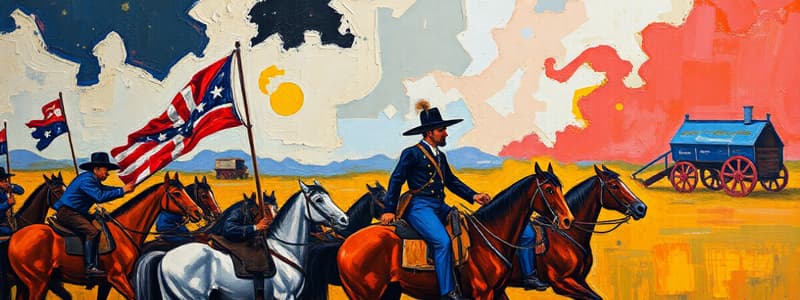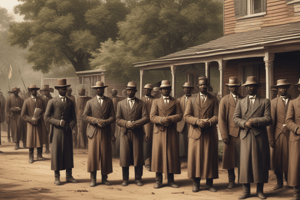Podcast
Questions and Answers
Match each Reconstruction-era group with its primary goal in South Carolina:
Match each Reconstruction-era group with its primary goal in South Carolina:
Radical Republicans = Advocating for the rights and political representation of African Americans. Freedmen’s Bureau = Assisting newly freed African Americans with education, jobs, and overall welfare. White Supremacist Groups (e.g., Red Shirts) = Opposing Reconstruction and suppressing Black voters through violence and intimidation. Textile Industry = Became a major employer in SC.
Match each term with its description during the Jim Crow Era in South Carolina:
Match each term with its description during the Jim Crow Era in South Carolina:
Segregation = The enforced separation of races in schools, transportation, and public places. Sharecropping = An economic system that trapped many African Americans and poor whites in cycles of debt and poverty on agricultural lands. Disenfranchisement = The use of laws and practices to prevent African Americans from voting, such as literacy tests and poll taxes. Lynching = Violence against African Americans.
Match the individual to their role during the Civil Rights Movement era in South Carolina:
Match the individual to their role during the Civil Rights Movement era in South Carolina:
Strom Thurmond = Efforts against integration, signing the Southern Manifesto to resist civil rights laws. NAACP = Legal battles for voting rights and school integration. Local Leaders = Voting rights and school integration through legal battles. Ben Tillman = Promoted white supremacy and led efforts to disenfranchise Black voters.
Match each event to its significant outcome during the era of Civil War and Reconstruction:
Match each event to its significant outcome during the era of Civil War and Reconstruction:
Match each Civil Rights Movement milestone with its impact on South Carolina:
Match each Civil Rights Movement milestone with its impact on South Carolina:
Match the figure in South Carolina history with their main contribution:
Match the figure in South Carolina history with their main contribution:
Match each cause with its effect during the Civil War era:
Match each cause with its effect during the Civil War era:
Match each economic factor with its impact on South Carolina between 1877 and the 1940s:
Match each economic factor with its impact on South Carolina between 1877 and the 1940s:
Match the following events with their primary impact on South Carolina:
Match the following events with their primary impact on South Carolina:
Match the following individuals with their roles during the Reconstruction era in South Carolina:
Match the following individuals with their roles during the Reconstruction era in South Carolina:
Match the following legal or political actions with their intended outcomes in South Carolina:
Match the following legal or political actions with their intended outcomes in South Carolina:
Match the descriptions with the correct political groups from South Carolina's Reconstruction era:
Match the descriptions with the correct political groups from South Carolina's Reconstruction era:
Match the challenges faced by African Americans in South Carolina with the methods they used to address these challenges:
Match the challenges faced by African Americans in South Carolina with the methods they used to address these challenges:
Match the event or era with its primary characteristic in South Carolina history:
Match the event or era with its primary characteristic in South Carolina history:
Match the following Supreme Court Cases with their impact on segregation:
Match the following Supreme Court Cases with their impact on segregation:
Match the descriptions with the correct political groups from the Civil War era:
Match the descriptions with the correct political groups from the Civil War era:
Match the descriptions with the people involved during the attack on Fort Sumter.
Match the descriptions with the people involved during the attack on Fort Sumter.
Match the description with the person involved regarding the Voting Rights Act passage.
Match the description with the person involved regarding the Voting Rights Act passage.
Flashcards
Secession
Secession
Withdrawal of a state from the Union.
Fort Sumter (1861)
Fort Sumter (1861)
First battle of the Civil War. Confederate forces fired on the fort.
Freedmen’s Bureau
Freedmen’s Bureau
Federal agency that aided newly freed African Americans with education and jobs during Reconstruction.
Ben Tillman
Ben Tillman
Signup and view all the flashcards
Segregation
Segregation
Signup and view all the flashcards
Sharecropping
Sharecropping
Signup and view all the flashcards
Disenfranchisement
Disenfranchisement
Signup and view all the flashcards
Briggs v. Elliott (1952)
Briggs v. Elliott (1952)
Signup and view all the flashcards
Fort Sumter Attack
Fort Sumter Attack
Signup and view all the flashcards
Freedmen's Bureau
Freedmen's Bureau
Signup and view all the flashcards
Red Shirts
Red Shirts
Signup and view all the flashcards
Ben Tillman's Impact
Ben Tillman's Impact
Signup and view all the flashcards
Southern Manifesto
Southern Manifesto
Signup and view all the flashcards
Civil Rights Push
Civil Rights Push
Signup and view all the flashcards
South Carolina Secession (1860)
South Carolina Secession (1860)
Signup and view all the flashcards
SC 1868 Constitution
SC 1868 Constitution
Signup and view all the flashcards
End of Reconstruction (1877)
End of Reconstruction (1877)
Signup and view all the flashcards
Study Notes
- The Civil War occurred between 1861–1865, and Reconstruction took place from 1865-1877.
Secession
- South Carolina seceded from the Union on December 20, 1860, fearing federal interference with slavery.
- Secessionists believed states could leave the Union, while Unionists disagreed.
Fort Sumter (1861)
- Confederate forces fired on Fort Sumter in Charleston Harbor, initiating the Civil War.
- The attack symbolized Confederate resistance to Union control.
- Confederate General P.G.T. Beauregard led the attack, and Union Major Robert Anderson defended the fort.
Reconstruction
- Federal troops occupied South Carolina to enforce laws granting rights to African Americans.
- The Freedmen’s Bureau aided newly freed African Americans with education and jobs, but some white Southerners viewed it as Northern interference
- Radical Republicans supported Black rights and representation.
- White supremacist groups, such as the Red Shirts, opposed Reconstruction and used violence to suppress Black voters.
- Reconstruction ended in 1877 as federal troops withdrew, enabling segregation laws.
Jim Crow Era & Early 20th Century (1877–1940s)
- Segregation laws enforcing racial separation in schools, transportation, and public places were enacted.
- The textile industry became a significant employer.
- Sharecropping caused economic hardship for many African Americans and poor whites.
- Ben Tillman, a SC governor and U.S. senator, promoted white supremacy and disenfranchised Black voters.
- African Americans encountered violence and disenfranchisement through literacy tests and poll taxes.
- The New South Carolina Constitution of 1895 restricted Black voting rights by introducing literacy tests and poll taxes to disenfranchise Black voters.
World War I (1914–1918)
- South Carolina provided soldiers and military training camps.
- Many African Americans migrated north for better job opportunities.
Civil Rights Movement (1920s and 1960s-70s)
- South Carolina was slow to accept civil rights changes but avoided the violent protests seen in other Southern states.
- Briggs v. Elliott (1952) challenged school segregation in South Carolina and influenced Brown v. Board of Education (1954), which declared segregation unconstitutional.
- Harry Briggs Sr. filed the lawsuit, and Thurgood Marshall served as the NAACP lawyer..
- Strom Thurmond, a South Carolina senator, opposed integration and signed the Southern Manifesto, resisting civil rights laws.
- Integration in South Carolina schools was slow despite Brown v. Board, with many white families moving to private schools.
- The NAACP and local leaders fought for voting rights and school integration via legal battles.
- African Americans pushed for civil rights through legal challenges, NAACP activism, boycotts, and voter registration efforts, facing resistance.
- The Southern Manifesto was a document opposing school desegregation, signed by Southern politicians like Strom Thurmond, arguing that integration violated states’ rights.
- In 1963, South Carolina began gradual school desegregation and resistance remained, but legal challenges forced change
- The NAACP pushed for integration, while White Citizens’ Councils resisted change
- The Voting Rights Act was passed in 1965 and strengthened Black political participation, and opposition remained in South Carolina.
- Martin Luther King Jr. advocated for federal intervention, while Olin D. Johnston initially opposed the act.
Studying That Suits You
Use AI to generate personalized quizzes and flashcards to suit your learning preferences.




